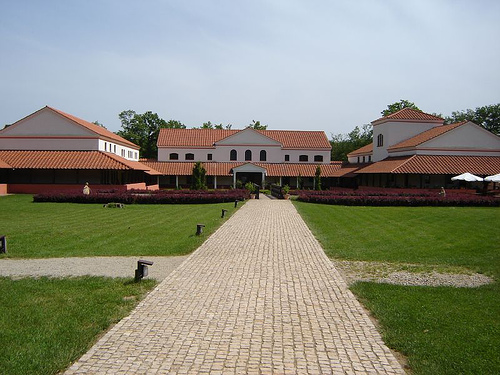

Location: Perl, Saarland Map
Constructed: 2nd century
Open: Apr- Oct 11am- 6pm
Nov- Dec 11am- 4pm
Feb- March 11am- 4pm
Closed: Christmas Eve- 1 Feb
Roman Villa Borg is a reconstruction of an ancient Roman villa that once stood here near modern Perl, Saarland in Germany. In the early 20th century the site was discovered by a local teacher Johann Schneider who started his private digging in the local mounds that stood out from local plains. There was no in depth exploration of the ancient site due to World War One and Two. Only in the 1980's did scientists got a chance to explore the historic settlement. Subsequently archeologists uncovered a private residence of a Roman nobility that date back to the second century AD. Additionally to the antiquity tools from the Beaker culture that date back to the Neolithic and Chalcolithic periods were discovered here. Since that an ancient mansion was reconstructed. This included gardens that once surrounded this prosperous residence. Pollen discovered here gave historians an idea on what type of plants were raised here. Every year a Roman Day is held here in the first week of August. Reenactment of the period, including horsemanship, Roman drill soldiers are held here.
Excavation findings and reconstruction
After
almost 100 years ago archaeological finds in Borg indicated a villa
rustica, planned excavations were started in 1987. It turned out
that a so-called protovilla had been built here on the site of a
late Celtic homestead in the early imperial period. This was then
followed by a stone construction phase. After evaluating and
assessing the excavation findings, it was decided in 1994 to
reconstruct the entire historical complex according to the findings.
Overall, the structure, which including the courtyard area extends
over an area of 7.5 ha, has three wings. The first buildings, the
tavern and the villa bathroom, were completed in 1997. The manor
house with the museum furnishings and the inner courtyard were
opened to the public in 1999. The third wing of the building, with
residential and commercial areas, was completed in 2001. The
gatehouse was also rebuilt.
The mansion, the reconstruction
of which is also being used as a regional museum for archaeological
finds, lies across the central axis of the complex. It has a large
lobby with an area of 100 m²; the furnishing was made on the basis
of found remains from Borg and the general state of knowledge about
such Roman buildings. The furniture as well as the doors, windows
and the hot water boiler in the boiler room are based on ancient
models. The reconstructed Roman bath demonstrates, among other
things, the function of a hypocaust. The restaurant in the Roman
tavern offers dishes based on recipes from Apicius.
In 2000,
as part of the Gardens Without Borders project, a Roman-style
garden, also open to the public, was integrated into the complex.
From July to September 2013, a Roman glass workshop was
reconstructed, which was then operated experimentally for the first
time in October 2013 as the 'Borg Furnace Project'. Research
projects with Roman glass took place in June 2014, May and June
2015, May and June 2016 and June 2017. The upcoming project is
planned for June 2018. The experimental archeological work area of
the Roman Villa Borg archeology park is currently being expanded
to include a pottery workshop, a metal workshop with a forge and a
second glassworks. These workshops are then available for
demonstrations, mediation and research projects.
Events
With the support of a sponsoring association, a number of events
take place on the grounds of the villa every year. The spectrum
ranges from special exhibitions to garden tours, literary and
culinary evenings, baking demonstrations and concerts. Particularly
noteworthy are the International Reenactment Fair IRM in spring and
the Roman Days on the first weekend in August. Regular guests in the
program of the Roman days are legions from Bitburg and Switzerland
and a group of gladiators from Pannonia. In 2011 Roman horsemanship
was demonstrated for the first time. There are also many stands,
exhibitions and a Roman canteen operated by the development
association.